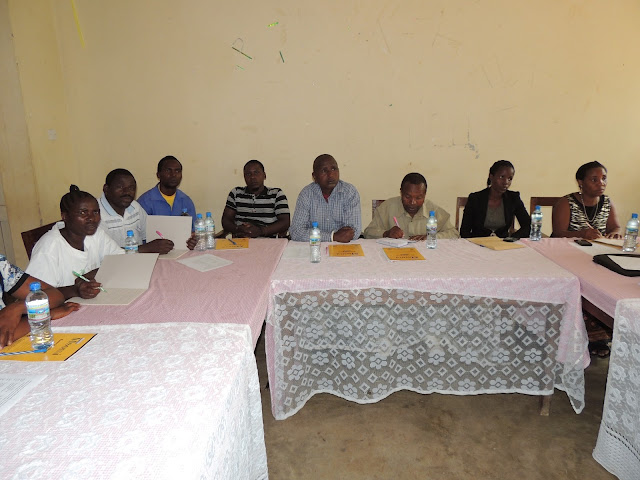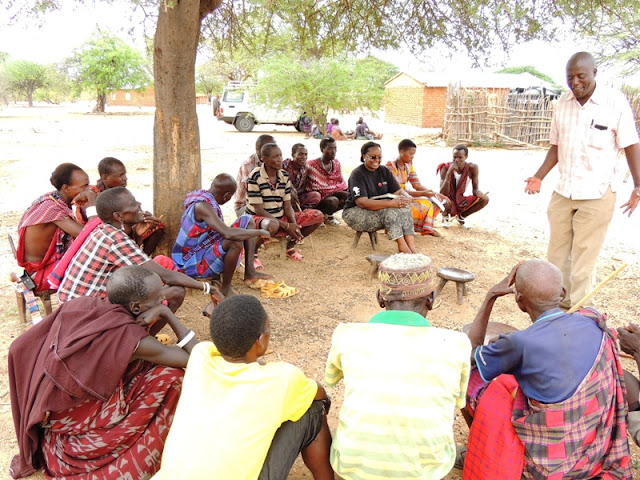Ofisa Nishati Jadidifu toka WWF, Phillipina Shayo
Mratibu wa Shirika la TAGRODE, Dickson Mwalubandu, akihamasisha jamii ya wafugaji wa kitongoji cah Kipanga katika Kijiji cha Chamndindi wilayani Iringa, mkoani Iringa kuhusu matumizi ya nishati mbadala juzi, ambapo aliambatana na Afisa Nishati Jadidifu (nishati mbadala) kutoka WWF Tanzania, Philipina Shayo (mwenye miwani aliyeketi). (Picha Friday Simbaya)
Shirika la Utunzaji wa mazingira duniani (WWF- Tanzania) (WWF-TCO) kupitia mradi wake Nishati Mbadala (RE) imeanza kutekeleza Mradi wa Nishati Mbadala katika Kijiji cha mfano Chamndindi, Wilaya ya Iringa ya Mkoa wa Iringa.
Ofisa Nishati Mbadala wa WWF Tanzania, Phillipina Shayo alisema mradi huo ni kuhakikisha upatikanaji wa bei nafuu, kuaminika, endelevu na wa kisasa wa nishati kwa jamii katika Kijiji Chamndindi pamoja navijiji vya jirani, hivyo kuimarika kwa ufanisi wa nishati.
Hayo yalifahamika Alhamisi wiki iliyopita wakati wa warsha ya kujadili mrejesho wa utatifi wa awali wa Nishati Mbadala (RE) kwa Kijiji cha Chamndindi ambayo iliandaliwa na Tanzania Grassroots Oriented Maendeleo (TAGRODE).
Alisema, kama vile kijiji cha 'Mabilioni' katika Wilaya ya Same wa Mkoa wa Kilimanjaro, Kijiji cha Chamndindi na wakazi wake wanakabiliwa na athari za ukame wa muda mrefu; hii ndio sababu kijiji hicho kumechaguliwa kuwa " Kijiji cha Mfano cha Nishati Mbadala ".
Mradi wa Kijiji cha Mfano Chamndindi wa Nishati Mbadala (CMREV) unatekelezwa na shirika lisilo la kiserikali la Tanzania Grassroots Oriented Maendeleo (TAGRODE) yenye makao yake makuu mjini Iringa.
Mkurugenzi Mtendaji wa TAGRODE, Zubery Mwachulla alisema kuwa lengo la mradi huo ulikuwa kuhifadhi na kulinda mazingira kupitia mbinu mbalimbali kuhusiana na shughuli ambazo kwa matokeo ya kuboresha hali ya maisha ya jamii za vijijini.
Mwachulla alisema ili kuhakikisha upatikanaji endelevu wa huduma za nishati ya kisasa kwa jamii maskini na makundi maalumu ilifanya utafiti wa awali wa kutathmini Teknolojia za Nishati Mbadala zilizopo katika Chamndindi Kijiji.
Pia alieleza kuwa mradi inalenga zaidi juu ya kuboresha upatikanaji wa nishati, kuongeza kipato kwa watu, kuongeza upatikanaji wa nishati mbadala, maji safi na salama na kupata maarifa mapana ya mazingira kwa ujumla.
Alisema kuwa mradi huo ilifanya utafiti wa awali ndio maana leo hii wamekuwa na warsha ya kujadili mrejesho wa utatifi wa awali juu ya Nishati Mbadala (RE) na shughuli ambayo ilikuwa ni matokeo ya warsha ya Alhamisi.
Mwachulla alisema kuwa uharibifu wa mazingira na matumizi makubwa ya kuni na mafuta ya taa katika Kijiji cha Chamndini na Wilaya ya Iringa kwa ujumla kumewalazimisha kujenga uelewa juu ya umuhimu wa matumizi ya nishati mbadala.
TAGRGODE ina kushirikisha wadau mbalimbali katika utekelezaji wa mradi huu yaani, WWF-TCO, Halmashauri ya Wilaya ya Iringa, Jumuiya cha Chamndindi na Makampuni Binafsi ya Solar na Makampuni ya ujenzi Biogesi.
Kijiji cha Chamndindi kipo kilomita 50 kutoka Iringa Town na kina kaya 568 na jumla ya wakazi 2,971 wataofaidika na mradi huo. Pia kina ekari chache za misitu hifadhi ya asili na baadhi ya wanyama kama vile ng'ombe, mbuzi na nguruwe.
Hata hivyo, WWF kupitia shirika la TAGRODE imechangia nishati ya jua yenye thamani ya milioni Sh74 kwa Zahanati ya Mwanzo Mgumu wilayani Kisarawe, Mkoa wa Pwani.
Mradi wa kuboresha huduma katika zahanati ikiwa ni pamoja na afya ya uzazi na wodi ya kujifungulia mwaka jana.
WWF - TCO inatekeleza Programu Nishati Mbadala kwa miaka mitatu (2014- 2016) ili kushughulikia vikwazo muhimu kutekeleza mipango endelevu ya nishati katika Nchi kupitia kuwawezesha vyama vya kiraia kuongeza sauti zao.















